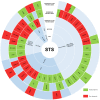Tumor and Peripheral Immune Status in Soft Tissue Sarcoma: Implications for Immunotherapy
- PMID: 34359785
- PMCID: PMC8345459
- DOI: 10.3390/cancers13153885
Tumor and Peripheral Immune Status in Soft Tissue Sarcoma: Implications for Immunotherapy
Abstract
Soft Tissue Sarcomas (STS) are a heterogeneous and rare group of tumors. Immune cells, soluble factors, and immune checkpoints are key elements of the complex tumor microenvironment. Monitoring these elements could be used to predict the outcome of the disease, the response to therapy, and lead to the development of new immunotherapeutic approaches. Tumor-infiltrating B cells, Natural Killer (NK) cells, tumor-associated neutrophils (TANs), and dendritic cells (DCs) were associated with a better outcome. On the contrary, tumor-associated macrophages (TAMs) were correlated with a poor outcome. The evaluation of peripheral blood immunological status in STS could also be important and is still underexplored. The increased lymphocyte-to-monocyte ratio (LMR) and neutrophil-to-lymphocyte ratio (NLR), higher levels of monocytic myeloid-derived suppressor cells (M-MDSCs), and Tim-3 positive CD8 T cells appear to be negative prognostic markers. Meanwhile, NKG2D-positive CD8 T cells were correlated with a better outcome. Some soluble factors, such as cytokines, chemokines, growth factors, and immune checkpoints were associated with the prognosis. Similarly, the expression of immune-related genes in STS was also reviewed. Despite these efforts, only very little is known, and much research is still needed to clarify the role of the immune system in STS.
Keywords: cytokines; gene expression; immune checkpoints; immune monitoring; immunophenotyping; soft tissue sarcoma.
Conflict of interest statement
The authors declare no conflict of interest.
Figures



References
Publication types
LinkOut - more resources
Full Text Sources
Research Materials

